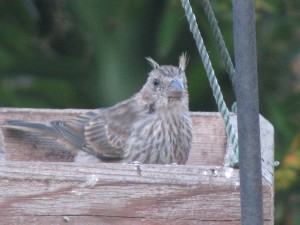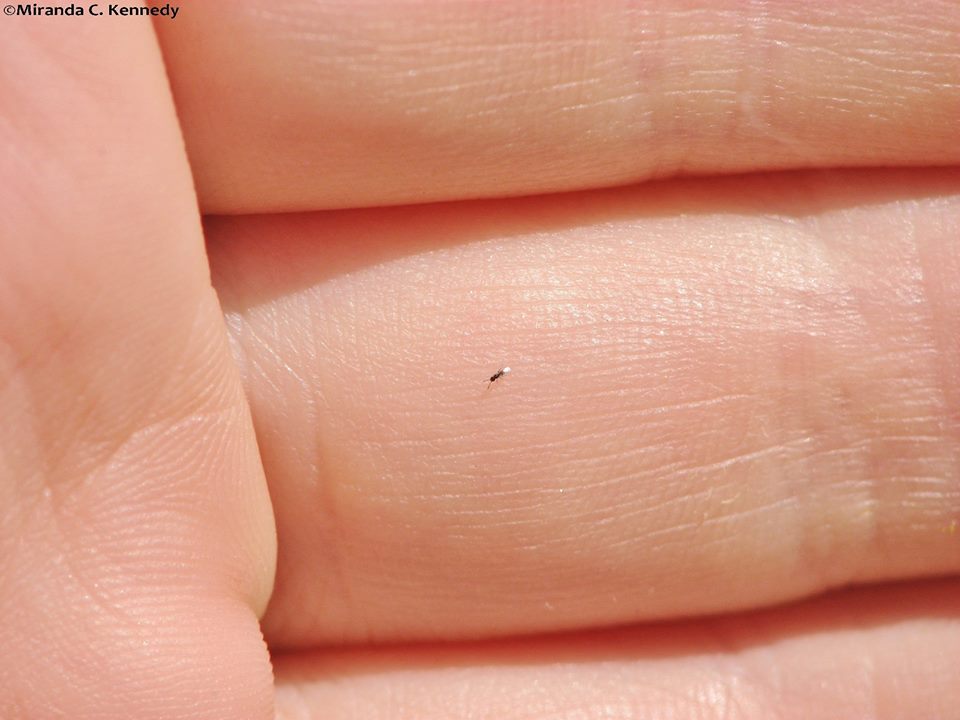Animals
-
San Elijo Lagoon Hike
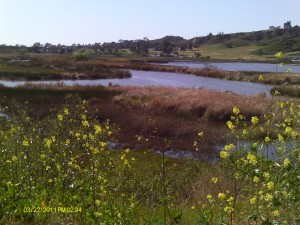
- San Elijo Lagoon
If you enjoy a hike along a flat trail with lots of nature to admire, you really should go to San Elijo Lagoon. Multiple times. That is because it has many different trails, most of which can be linked together for a long hike.
San Elijo Lagoon is protected by the San Elijo Lagoon Conservancy, the County of San Diego Parks Dept., and California Fish and Game ( http://www.sanelijo.org/welcome-san-elijo-lagoon-ecological-reserve). It is one of the largest wetlands in San Diego County, and the estuary is a wonderland for birders. The lagoon lies between Encinitas and Solana Beach, and occupies about 1,000 acres.
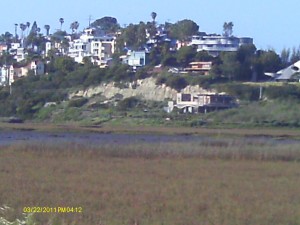
The Nature Center is run by the County and staffed by two rangers. In the photo at left it is the lowest building to the right of the cliffs. It is an fine example of a ‘green’ building, using solar, reclaimed water, a green roof and much more. Inside are very cool interactive computers and displays demonstrating how tides effect the estuary, the history of the area, and much more. Outside of the Nature Center is a boardwalk trail loop with benches and interpretive displays. During the change of tide there is a great opportunity to watch any number of seabirds fishing right next to the walkway. Watching the glorious sunset with the Coaster zooming past and cormorants fanning their wings on the telephone pole makes it easy to feel very, very happy about living in San Diego.

The Nature Center has a parking lot, and it is accessed from Manchester Ave. Visit the website for exact directions. The parking lot does have hours of closure, and this loop trail is independent from the other trails.
If you continue along Manchester you’ll see a sign for the Lagoon’s Dike Trail on the right. You have to park along Manchester Ave. Walking along the dike is one of the best ways to see dozens of seabirds, some in flocks of hundreds, very close-up. If it has been raining, you may want to check the condition of the dike because, as we found out, it can overflow.
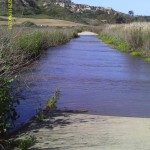
Once across you have the option of hiking West or East. If you opt for West, you eventually walk under I-5, which is an interesting experience in itself, then around through old Eucalyptus trees under the eroded cliffs overlooking the estuary. You have a choice of two trails which connect later, one takes the high road, and one takes the low road, so to speak.
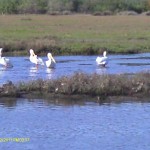
The lower one skirts the water and the higher one leads you through tall native plants. There are lots of flowers, birds, lizards, and interesting plants on either hike. At the end of the lower trail there are interpretive signs. The trail leads up to a trailhead off of North Rios Avenue, where there is street parking. You can continue West from there down to another walkway out into the wetlands for good bird viewing, and even further around the water and close to the train tracks past the water treatment plant (which is a little smelly) and out to where there are interpretive signs describing huge sewage tanks that had been at the site. That is as far as you can go, and you have to turn around and hike back.
Southeast of the Dike Trail are several miles of hiking that extend almost all the way to El Camino Real. There are several more trailheads to drive to and park.

There are lots of joggers and hikers. The pathways are well maintained and I’ve rarely had to pick up any trash along the way. Along with many seabirds, songbirds and raptors you may see mule deer and find the tracks of nighttime visitors such as coyote and racoon.
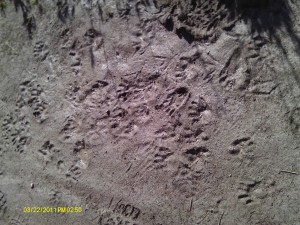
Although the hiking is along a flat area, there is a lot of it and the coastal sun is deceptively hot in that cooling breeze. Take lots of water, comfortable shoes (you can get them on shoe hero), a hat and sunscreen, and a jacket in case the famous low clouds and fog come blowing in.
This is a wonderful area for good exercise through several different plant communities with lots of good birding opportunities. You can’t do it all in one go, so plan for several trips, keeping an eye on the tide tables. Plan it around a good dinner at a coastal restaurant (such as Siamese Basil Thai restaurant in Encinitas… my favorite!) and an even beach stroll… sounds like a wonderful day to me!
-
Chicken Update (or The Pulletzer)

Rooster To follow my previous post about my darling chicks, who are becoming more colorful and lovelier in their scrawny-necked way every day, I thought I’d update the chicken-fanciers out there. You know who you are! I still wanted two more kinds. I waited on a local feed store for their order to come in yesterday, ran over there today… and they didn’t have what I wanted. We have, if you remember, a Buff Orpington, a Rhode Island Red and a Silver-laced Wyandotte. I wanted a Barred Rock, which is the traditional black and white rooster that is reproduced on tea towels, collector’s plates, etc. I also wanted an Araucana (also known as the South American Rumpless, but I won’t tell the girls that). Apparently they have ‘improved the breed’ and renamed them Americaunas. These are beautiful birds, with brown swirled patterns and each chicken a little different. They lay eggs that range from blue to green (just the shells, mind you!) and are very nice chickens. They are also extremely popular and sell out right away (so the feed stores were telling me) and the hatcheries were out of them. Frustrated and brooding (!) about it, I felt a little peckish (!!) and had some lunch then scratched around (!!!) for a phone book and called Country Feed Store in Vista. They had both kinds! Off I flew (!!!!) and bought two 4 week-old Americaunas (my ladies are about a week younger, so I put them together and so far no pecking),
 Americaunas
Americaunasand two one-week-old Barred Rocks.

Barred Rock So cute! I went into the Brood House there and they had so many little chickies! I crowed with delight (!!!!!).
When my daughter and I looked for chicks there a week ago, it was between the rains and we didn’t see what we were looking for. However, as we were standing there in the wet straw we turned and saw a little rooster with wild wet feathers standing just around the corner of one of the pens and staring at us.

Frizzle We stared back. He kept watching. He looked mentally unstable. We moved on and were a ways away talking about a couple of free-roaming geese when I looked past my daughter and nudged her, “Look behind you,” I whispered. There he was! He was doing the same thing, just standing there just around the corner of the last pen, staring at us, feathers all crazy. Creepy! He eventually wandered off but I managed to take a photo of him. Today he was there still, wandering around with feathers in a little better shape. He was crowing mightily for his small stature and listening for a return crow from somewhere distant. I asked the young man who was helping me ( a great guy he was, too. It was about ninety degrees and he was loading bales of straw, helping customers and dealing with animals all with a sweet smile on his sweaty face!) about the rooster, and he said he was a Frizzle! The rooster, that is. The rooster had come to them with messy feathers, and he said he’d cleaned up a bit. I love that rooster. If I didn’t think my neighbors would snap and come over with torches, I’d have that rooster just as a pet. A mean, deranged, cantankerous pet, but so what? I have cats who are the same way. The store had two-day-old Frizzles, too, but at that age there is a 50/50 chance of getting females, and I want hens for eggs. Sigh. So the little Barred Rock are in a box next to the other older ladies, sharing a heat lamp (not today they weren’t… so hot!) and with a little antibiotic and vitamins in their water. I tossed some cauliflower leaves in with the older girls, but they thought they were monsters for awhile, then laid on them for a nap instead of pecking away at them. Still kids.

The Older Girls -
Chicken Tractors
To most people a chicken tractor sounds like some lame joke. Until fairly recently, I did too. However there are whole websites devoted to them. And as of this week, thanks to local carpenter Jay Tull, I am the proud owner of one!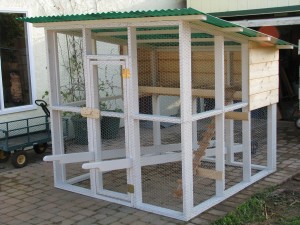
Chicken Tractor One of the fundamental ideas of permaculture is a holistic approach to land management and food supply. Keeping animals that produce food in a compassionate, healthy and useful manner is part of the puzzle. I am a lacto-ovo vegetarian and want dairy products that are produced using humane methods. Therefore, a chicken tractor! A chicken tractor is a movable coop with an unlined bottom. The chickens root around eating bugs, digging up weeds and pooing within the safety of their lovely tractor. You throw in some straw and they mix it into the soil and poo on that, too. In a few days or a week, that square of soil has been dug up, mulched and fertilized and it’s time to move on! So you move your tractor, chickens and all, to wherever you would like them to work next. Meanwhile you collect enriched eggs that have been laid by unstressed chickens who supplement their mash with bugs and greens out in the fresh air.
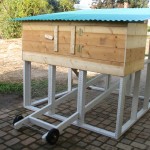
Back view If you have ever eaten eggs from backyard chickens, it may take a little getting used to. That is because the flavor is so interesting and fresh. Going back to supermarket eggs is like switching from chocolate to carob: as a satisfying substitute it just doesn’t fit the bill.
Chicken tractors come in all shapes and sizes. Check out these images: http://home.centurytel.net/thecitychicken/tractors.html. I must admit that my chicken tractor turned out heavier than I’d like, but it’s beautifully made and I’m very happy with it. We’ve joked about entering it in the Christmas parade. If you’re interested in chicken tractors (or chicken arks as they are also called), read Chicken Tractor: The Permaculture Guide to Happy Hens and Healthy Soil by Andy W. Lee. The San Diego County Library system has copies. (Did you know that you can order books from any County library online and it will be shipped to your local library? Visit https://dbpcosdcsgt.co.san-diego.ca.us/search).
This tractor is large enough for maybe four or five chickens at most, which would provide more than enough eggs for me. There are hundreds of web pages that focus just on chickens, and a handy chart that lists egg-laying characteristics can be found here http://www.mypetchicken.com/chicken-breeds/breed-list.aspx, as well as other places. Many birds lay brown eggs or bluish eggs; they don’t have any difference in any respect than white eggs other than shell color, so to pay more for brown eggs at the supermarket is criminal.
Oh, and of course, if there is a chicken tractor, there must be chicks:
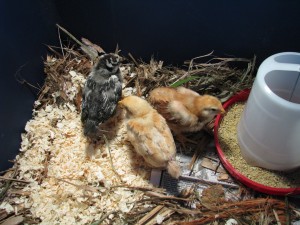
Two week old chicks These three ladies are two weeks old, and are from left to right a Silver Wyandotte, a Buff Orpington, and a Rhode Island Red. I want an Ameraucana (which is a hybrid of Aurucana, which lays the greenish and bluish eggs), and a Barred Rock, which is the traditional black and white chicken, but there were none to be had today as they are very popular. When some become available I’ll raise them seperately until they are mature and introduce them to these three so there is no bullying. Chickens lay eggs without a rooster, and do quite well without being harrassed and pecked at, too. My neighbors wouldn’t forgive a rooster, either. Right now my little chicks are too young for the Tractor, so they live in a Rubbermaid 50-gallon storage container with a 60-watt lamp on one side, water and mash in separate containers, newspapers and shredded bark underneath, and wire across the top because they are Chickens make wonderful pets and have a welcome spot in any permaculture system. Besides, they’re very cute.
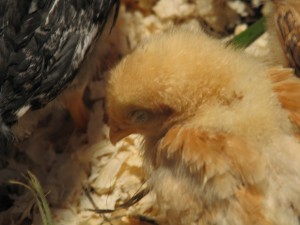
Sleepy chick (Photo credit: Miranda Kennedy)
- Birding, Gardening adventures, Heirloom Plants, Permaculture and Edible Forest Gardening Adventures, Photos
Brief Garden Updates

Palm Throne I spent the day making two birthday cakes for my two children, both of whom will be flying in from different directions tomorrow. Recipes will be the next thing I post! So for now, just a few garden updates. As you can see in the photo above, I have yet another palm throne, this one at the entrance to the garden. These are so fun. As the palms decompose, I can always plant in the seat!

Six loads of rock A total of six truckloads of rock have been delivered, and are piled in various areas on the property. At about 12 tons a load, that’s over 700 tons of rock! These will be used to surround the ponds, line the dry streambeds, and as interesting features in the natural garden.

- Garbage Can Enclosure
Jay finished the enclosure for the garbage cans, and it is pretty ritzy. Those incredible hinges are hand-made and you can see the imprint from the blacksmith’s tools on them. Jay had several sets and I had to have them. I go nuts over skilled craftsmanship, such as woodworking and metalwork. Right now there is only a latch on the outside, so it would pay not to close the door while inside. It would be a little climb and a long reach to get out again.

- Frond Fence
Along the radically improved and stabalized area above the embankment, some of the chain link and posts used to hold the soil were showing. So today lots of pond fronds (hey, we have a lot of them!) were being attached to the exposed fencing as camafloge. It looks great in that area. Also, little birds like house wrens love nipping between old palm fronds, and they’ll provide some hiding areas for the Western fence lizards, too. The stairs were made from railroad ties, and the area around them planted and then mulched with palm chips.
In the bulb beds, one of my favorite daffodils has opened today, and unfortunately I was snapping photos in the evening and the close-ups were blurry.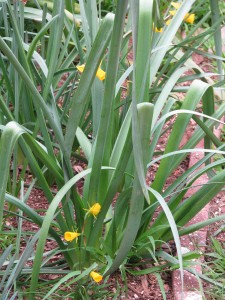 At the bottom of the bulb photo are Hoop Petticoats, and at the top, Little Witches, which I wrote about the other day. The little center unruffled hoops are so unique; besides Rip Van Winkle (which haven’t bloomed yet) these are my favorite.Also, Double Delight rose has bloomed. It is a double delight because its coloration is gorgeous and ranges from almost pure reddish pink to almost all white with some red on large, softly ruffled blooms. It also is extremely fragrant; my daughter said that it smelled the way rose water tastes, and that is perfectly true.Meringue Mushrooms coming up soon!
At the bottom of the bulb photo are Hoop Petticoats, and at the top, Little Witches, which I wrote about the other day. The little center unruffled hoops are so unique; besides Rip Van Winkle (which haven’t bloomed yet) these are my favorite.Also, Double Delight rose has bloomed. It is a double delight because its coloration is gorgeous and ranges from almost pure reddish pink to almost all white with some red on large, softly ruffled blooms. It also is extremely fragrant; my daughter said that it smelled the way rose water tastes, and that is perfectly true.Meringue Mushrooms coming up soon!
-
Permaculture Update
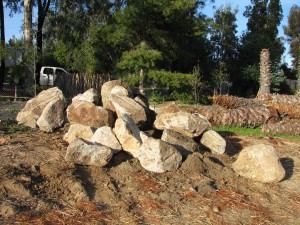
A Pile of Rocks As promised, I have more photos for you. Roger and his team have worked with all stops out for this last month and a half. Lots of heavy labor, skilled work and planning has been done. One of the big decisions that needs to be made next is about water. Besides digging a couple of unlined rain catchment ponds, which will perculate run-off into the soil and be dry most of the year, should there be a lined pond that would stay wet all year for birds and other wildlife. This pond would be cleaned by filtering the water through a bog area. Also, should I invest in a huge above-ground water tank to collect the thousands of gallons of water that pours off my house roof during rainstorms? So we are interviewing pond builders, and having pow-wows with other professionals who know about water.In the meanwhile, many trees and small plants have been planted, about half the pile of urea spread and tilled in.
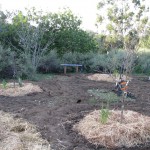
Tilled and mulched I am not an advocate of tilling in healthy soil. It tears apart the microbes and underground inhabitants that are what changes dirt into soil. About twelve years ago when I first moved here, I succumbed to those enticing Troy-Bilt tiller ads and purchased a 6 HP tiller; an enormous investment at the time, but with all this weedy property I thought it would help me ‘fix’ the soil. The tiller came dismantled. After a lot of trouble putting it together and getting it running, the machine I bought turned out not to be a tiller, but a device that endeavors to separate your arms from your torso and dislocate each vertibrae in your spine, all without actually tilling anything. The Troy-Bilt ad photos that show a neatly dressing young woman casually standing by her tiller pushing it with one hand, leads one to believe that the tillers are easy to run. Actually, the lady in the photo is having a good time only because the tiller isn’t turned on! She’s leaning on it! Someone made all those groves in the dirt with a hoe, because that tiller sure didn’t! You may surmise from that rant that I didn’t have much luck tilling, so the machine sat in my shed until recently. It was just repaired and yesterday, having been starved for so long, it tried to eat Roger as he used it around my property. Roger is a big, strong man, so I don’t feel so badly about having been so unsuccessful with using the tiller that I wanted to chain it in a dark celler where it wouldn’t hurt anyone again. Despite the evil tendancies of this machine, much urea has been tilled in around the planted trees, which is the first layer in the plant guilds that form the edible forest garden. Under the trees, other components of the guilds are being planted. Those components perform what roles plants in a natural forest hold: mulchers, groundcovers, shade, insect-attractors, nitrogen-fixers, and nutrient-miners. The guilds will grow larger as the project unfolds.

Jose and Roger with the first load of rocks Rocks are a wonderful focal point in any garden, and we needed a lot of them. With predicted rain this weekend, and the probability that the 10-wheeler wouldn’t be able to access the yard with the soil any softer, sped up the delivery date to… ASAP. Two deliveries of boulders were deposited today, and starting at 7 am tomorrow, several more loads will be dropped. I can just see all the lizards on the property rubbing their little hands together in anticipation of a great king-of-the-hill push-up contest. Two sections of my wooden fence had to be disassembled so the truck could pull directly into the yard. Later, the boulders will be placed with a small Bobcat. This is a nice mixture of rock, and this first load pictured shows the largest of the boulders. This is about 12 tons of rock. I can’t wait for time alone to go climbing! 🙂
I asked Roger if he knew a really good carpenter to help build some items for me, and he did. Local carpenter Jay Tull was brought into the job and is also a craftsman of skill, inspiration, problem-solving, and a lot of fun ideas. He made two top-bar bee hives first of all (I’ll go into bee hives in another post, as well as my blue bee garden), using almost all leftover materials on the property. They are beautiful. Next, I wanted to build a little fenced area to block off my trash and recycling cans so my long-suffering neighbors didn’t have to look at them anymore.

Garbage Can Closet or Guest House? So with lumber and more of that broken concrete (which actually came from his property!), he and Roger’s team are working on an incredible enclosure that probably should be a guest house! The walls, made of leftover fencing, and a gate will be added probably tomorrow after the cement all dries. Jay suggested that the cement chunks be cemented in rather than surrounded with gravel for easy hosing down. There is room for a planter on the side! Another project Jay is working on concurrently is a chicken tractor.
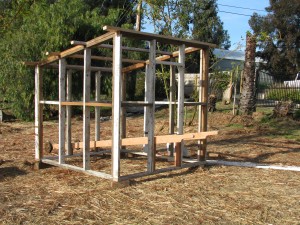
- Chicken Tractor in the Making
There are many websites devoted to just images of chicken tractors. These are portable chicken coops that rest on the ground. The idea is that the chickens root around in the ground weeding, pooing, eating bugs, etc., which is all extremely healthy for the birds and great for the soil. Then in a few days you move the tractor a little ways and set it down and they start on a new batch. I found a photo of one I liked, and Jay is building it almost entirely out of used wood from my old sheds, and wheels off my old gate. It works like an extremely heavy wheelbarrow; apparently the image I gave Jay to work from used two people to move it, but he’s adapted it for one person. I’ll show you the finished version in a couple of days. We’ve already joked about entering it in the Fallbrook Christmas Parade.
Other things that have been going on are the building of benches and seats for viewing areas around the property, using the materials that are here.
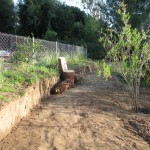 Jose and Francisco, Roger’s team, have stripped some of the palm trunks and cut them into chairs. This shows one set up on the newly repaired erosion area just above the barranca. Along the fence are planted more stonefruit, and on the other side of the fence are planted berry vines. The seat overlooks the mature toyons, sumac and willows that grow down the embankment, and a great place for bird watching. A garden isn’t a garden if there aren’t resting places for you to just sit and listen.
Jose and Francisco, Roger’s team, have stripped some of the palm trunks and cut them into chairs. This shows one set up on the newly repaired erosion area just above the barranca. Along the fence are planted more stonefruit, and on the other side of the fence are planted berry vines. The seat overlooks the mature toyons, sumac and willows that grow down the embankment, and a great place for bird watching. A garden isn’t a garden if there aren’t resting places for you to just sit and listen.  Stumps along the Liquidamber Allee
Stumps along the Liquidamber AlleeToday Roger saw an adult kingsnake under the native plants on the embankment, and it startled and slithered away. I think this may be our annual visitor to our upper pond and birdbath. Every summer he shows up once or twice looking for mice and getting a good long drink from our pond, then disappears. I’m hoping he has his eye on our gopher population.

California Slendar Salamander So the loud machinery, sounds of screeching rocks sliding on metal, and the whiff of urea continues on my usually quiet and unobtrusive property. Some day in the near future it will again be quiet, and all the animals I’ve scared off will return. Actually, many birds have been enjoying the piles of brush, and Roger has encorporated some brushy piles into the design just to allow the birds and bunnies and lizards small havens.
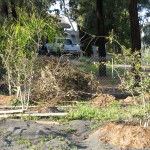 These piles are small, and are located well away from the house so as not to cause a fire hazard. Also I was sorting through the stack of old plywood on the weekend and uncovered two California Slendar Salamanders. One was larger than the other, so I think that was the female. I removed them to my upper pond area so that they wouldn’t get squished. These wonderful discoveries of life on my property make me all the more determined to complete this project in as a compassionate and organic way as possible.
These piles are small, and are located well away from the house so as not to cause a fire hazard. Also I was sorting through the stack of old plywood on the weekend and uncovered two California Slendar Salamanders. One was larger than the other, so I think that was the female. I removed them to my upper pond area so that they wouldn’t get squished. These wonderful discoveries of life on my property make me all the more determined to complete this project in as a compassionate and organic way as possible. My two elderly dogs, Sophie and General Mischief, have been having such a hard time of it. They lived their lives here outside, sleeping on an old futon in a small garage-type building. Now that they are both deaf, and Sophie likes to sneak out to go visit my long-suffering and wonderful neighbors, I’m afraid of them being injured with the gate opening and closing and large trucks pulling through. So, for the first time in their lives, they’ve had to adjust to living in my library on a sheet-protected couch. You can see how hard it is for them:
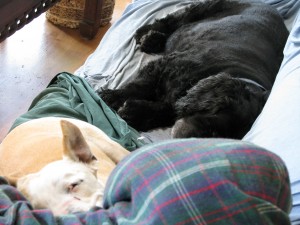
Suffering Couch Potatoes -
Hiking the Observatory Trail

- Pines on Palomar
For those of you who are waiting for an update about the permaculture garden, I’ll do that tomorrow or the next day. Many small things, although labor-intensive, have been happening, and some big things are happening tomorrow, so I should have good photos to share.Meanwhile, today was hiking day, and a gorgeous day it was. My hiking buddy Alex came up with an old magazine article about the Palomar Mountain Observatory Trail, which neither of us had heard about. You drive up to the gate that leads into the Palomar Observatory parking lot and look right… and there is the trailhead.

The Observatory closes this season at 3, and the parking lot at 3:45, so we parked on the street past the ‘no parking’ signs. (Disclaimer: These photos were taken with a lightweight cheapy digital camera which I use now when hiking instead of the big heavy camera, so the resolution isn’t superb.) To our surprise on this warm Spring day, there was still snow along the roadsides.

Snow Flower Alex made a Snow Flower instead of a Snow Angel. So artistic.
If you decide to hike this trail, at the sign there is a well-worn path to the left and a not-so-well-worn path to the right. We, of course, not taking Robert Frost’s advice, took the well-worn path, which led us into a maze of cut brush piles, fallen logs and criss-crossed paths. We laughed about survival skills just to get through the first five minutes of the trail. On our return we clearly saw the real pathway that was beautifully laid out, skirted the brush pile maze, and came around to the other side of the entrance sign. Of course. This trail is supposed to be 2.2 miles one way, and it travels downhill through mixed pine and oak forest, paralleling the roadway a lot of the time, until you reach the Observatory Campground. Then you have to hike uphill on the return. During the time of year that the campground is open (it isn’t now), you can park there and hike uphill first to the Observatory, take a tour and hike back down. Not all of the pathway is shaded, and it wasn’t a hard trail at all (if you didn’t get stuck in the brush piles!).

Woodpecker Tree If you are a birder, this is a wonderful area. I saw red shouldered hawks, nuthatch, spotted towhee, banded pidgeons and of course plenty of acorn woodpeckers. Woodpecker families ‘own’ trees. In the Fall when oak acorns drop, they compete with many other animals who eat the nuts for their high protein value. The acorn woodpeckers grab an acorn with their beak, fly up to the family tree, then nod and shake their heads slowly measuring the acorn up and down. Then clasping it in their feet they drill a hole exactly the size of the acorn. They jam that acorn in so that no one can get it out. They fill trees (and the sides of houses, too!) with acorns, and this is their pantry. Since acorns fall only once a year, this storehouse has to help feed the family for a year, with the addition of insects to their diet. During the year the woodpeckers will check on the acorns buried in the bark, and if the nuts have shrunk, they redrill a smaller hole for it. At this time of year and on into early summer you should be able to spot activity in tree cavities.
 What a wonderful thing it is to see later in the season little red and black heads peering out of their nest!
What a wonderful thing it is to see later in the season little red and black heads peering out of their nest!This area had been burned in the past, and the trees still show the burn marks.
 Many of the deciduous oaks are still bare, and there are stands of very old incense cedars,oaks and pines. The heavy smell of resin permiated the air, making me feel a little sleepy in the sunshine. What a fragrance! The terrain changes a lot, from shady forest, to streambed with a log crossing, to open areas bordered with manzanita just going into bloom.
Many of the deciduous oaks are still bare, and there are stands of very old incense cedars,oaks and pines. The heavy smell of resin permiated the air, making me feel a little sleepy in the sunshine. What a fragrance! The terrain changes a lot, from shady forest, to streambed with a log crossing, to open areas bordered with manzanita just going into bloom. Against the bluest of blue skies some of the white-barked bare trees made wonderful designs. A little more than two-thirds of the way down, you get to a platform jutting away from the trail, and from there is a view well worth the hike (if the beauty of the forest wasn’t enough). Down across the tree-studded mountain you can see the sweep of Mendenhall Valley, with brilliant green grazing land studded with cows and ponds.
Against the bluest of blue skies some of the white-barked bare trees made wonderful designs. A little more than two-thirds of the way down, you get to a platform jutting away from the trail, and from there is a view well worth the hike (if the beauty of the forest wasn’t enough). Down across the tree-studded mountain you can see the sweep of Mendenhall Valley, with brilliant green grazing land studded with cows and ponds.
Mendenhall ValleySnow We also passed an area where there had recently been a controlled burn to clear out the undergrowth. Then we’d dip down and cross a streambed with mossy rocks and deep, spongy loam.
Streambed 
- Along the pathways were boulders ranging from gigantic, mossy troll-like beasts, to well-constructed stone retaining walls.

Stone Wall 
Smaller Observatory From the path you can see the smaller of the two observatories glinting in the sun. How fortunate we are to live so close to such a famous research facility! You of course know that there are two roads up to the observatory because the first one switched back and forth too much for the truck to navigate that was hauling up the huge lens, so the second one is more straightforward. When traveling back down the mountain there are many scenic pull-outs. Take advantage of them, even if you’ve stopped many times before! The view down into Pauma Valley, and across the shapely mountains and hills that roll right out to the Pacific, is a reminder of how beautiful the land is and how lucky we are to live here.

Out to the Sea I apologize for the random craziness of the photos. I’m trying to insert them where I want after uploading them one at a time (whew!), and the program doesn’t agree with my placement. In fact, I just posted this and about four of the photos had disappeared, so I had to readjust. A work in progress!
-
Birds

Nesting season has begun. The raptors have been screaming and chasing each other for a couple of months now, making all the little birds uneasy. I’m not overly fond of crows (they are vicious to other animals for fun), but I respect them. These two have routinely preened each other on the telephone wire over my front yard for a couple of years. Now they are making a nest in the pine tree in my driveway. The weeds that I have pulled and tossed back onto the ground to decompose and return all that nutrition back into the soil, have become prime nesting material for Mr. and Mrs. Crow.
My front yard is a National Wildlife Habitat, with a plaque and all. Actually, you meet the qualifications of providing shelter, food, water and nesting areas, make a donation, and the National Wildlife Foundation sends you a plaque. Feels righteous anyway. In this yard we have a small pond, a multitude of bird feeders, and lots of bird and butterfly friendly plants.

This yard is forever changing because I futz with it. My daughter and I dug and laid the pond (the flagstone and pond liner were free!), and I plant things, challenge them with neglect, and see what happens. We have so many feeders because from our dining room window we watch the birds. It is incredibly time consuming. You sit for a minute to watch some white crowned sparrows, and suddenly its two hours later. My daughter, who is studying Wildlife Conservation focusing on wild birds at Oregon State, is a far more intense birder than I am. She also participates in the Cornell University Project Feederwatch, and in her absence I do the counting on the weekends. http://www.birds.cornell.edu/pfw/ . She’s logged over 65 species of birds in our little front yard alone.
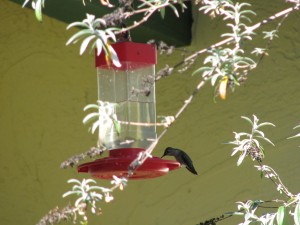
Migratory season has begun, and you should be seeing and hearing a lot more hummingbird activity. We have a couple of hummers who are year-round residents here in San Diego, most notably the Anna’s Hummingbird. If you see a hummingbird fly up incredibly high in the air then divebomb, and hear a small whistle followed by a chittering call, that’s our Annas.

They divebomb to protect territory and to impress the opposite sex. The whistle is made by the wind whistling through their tail feathers as they pull out of their dive; in fact, the height of their dive is probably to make a really impressive and fearsome whistle. Then they do their warbling chitter right after. Have to boast, after all. Here in North County you’ll see (and hear… he buzzes when he flies) the Rufous Hummingbird, Costa’s, and Black-Chinned. There are other varieties in other areas of San Diego as well, but these are the competitors around our house. And boy do they fight. Hummingbirds are so incredibly territorial that they will try to kill each other, then must fill up with nectar to feed that incredibly fast metabolism. During mating season they pretty much eat to fight. Its funny to see them call a temporary truce at the feeders so they can all drink, then go off and chase each other again. Hummers eat bugs, too. If you see one doing some weird flying in a place where there doesn’t seem to be any food, then they are probably gathering cobwebs which they use to line the insides of their nests, along with other things.

If you put up a feeder, you may want to consider a couple of things. One would be buying a feeder with bee guards, as in the above photo. Bees need food and water, too, and they love hummingbird feeders. However, sugar water is not good for bees or for their honey, and certainly not good for the hummingbirds. (I’ll talk about bees another time; I keep bees, too. I know, I know.) The above design hasn’t impressed me because the bottom tends to fall off, but there are better designs. You don’t have to buy nectar. Boil four parts water and add one part white sugar (not honey or brown sugar), then stir to dissolve and allow to cool to room temperature. You do not need to color the nectar red! Supplement the feeders with plants that hummers love such as fuchsias and hummingbird bush, so that they can feed on real nectar that has all the vitamins and minerals that they need. Always provide water, too, such as in a bird bath or a mister that they’ll love to fly through. If you do have a feeder, you must take care of it weekly in the wintertime, and every few days in the summer. Why? Because a black mold grows on the sugar water, especially where the hummingbird puts its beak to drink. That mold will cause a beak fungus that can be deadly to the bird. Instead of helping and enjoying the birds, you will be killing them. Mold is easily found floating in the water, clinging to the sides of the feeder jar, and blackening the feeding holes. To clean your feeders you should bleach them.

I fill half of my kitchen sink with hot water, dump in about 1/4 cup of bleach (I don’t measure), and then carefully without splashing on yet another shirt like my favorite purple tank top that now has a white spot on it, with rubber gloves on, I submerge the feeders and let them soak for about 15 minutes while I go off and forget they are there until I smell the bleach and remember. I use a long narrow bottle brush to clean the insides, and make certain that the feeding areas where their beaks will go in are scrubbed. Then I rinse everything in cold water and fill with the cooled sugar water and hang. If I’m coordinated enough I’ll line up other things that need bleaching so I don’t waste the water, such as something not-quite-white anymore, the cat food bowls and the compost bucket. Since my house is on septic I try to remember to put some of that black bacteria stuff down the drain afterwards.
Ants are a real problem with feeders, and the only organic thing I’ve found that really works is to coat the top of the feeder and the hook from which it hangs with Vasaline. During the really hot summers it does melt, so I have to reapply a couple of times, and make sure that nothing touches the feeders to give the little devils a bridge. But, it works! And without spraying poison.
Just to leave you with a happy image, here is a perennial bird favorite. The House Finches are all over Fallbrook; the males all colored up red in the front and the women daintily brown striped and everyone looking their most attractive as they choose their mates. Almost every year, however, some female will have an unfortunate molt. A bad feather day. Evidence of the cruelty of life without mirrors. We call the unfortunate one: Devil Finch.
